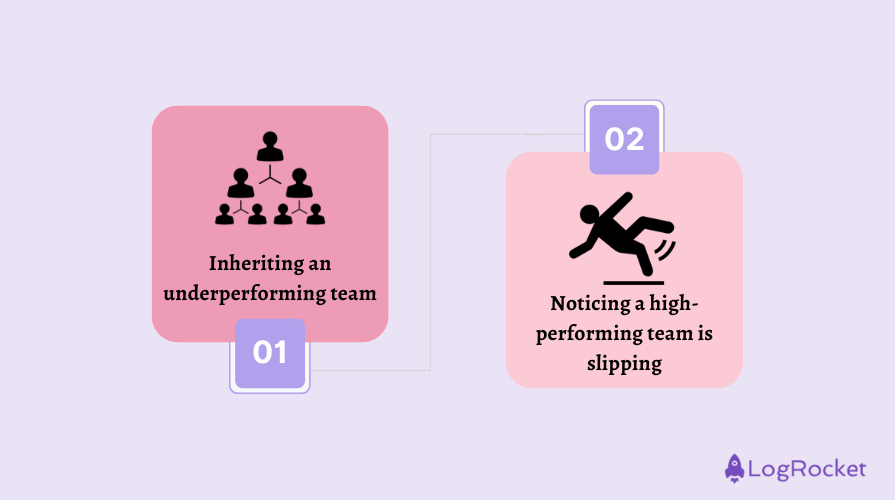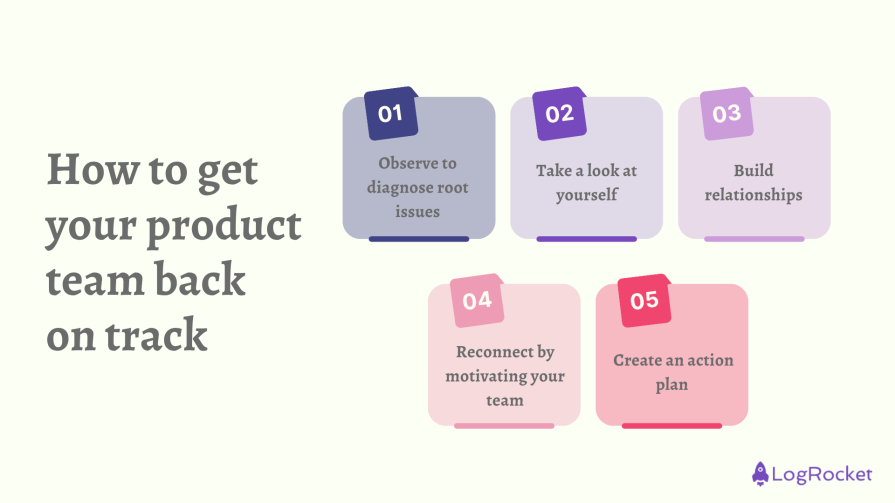5 steps to get your product team back on track
As a product manager, having to deal with an underperforming team can be challenging. Guiding a team back to productivity takes a lot of effort, hard decisions, and strong leadership skills. However, the good news is that it presents you with an opportunity to make your impact visible.
To help you get started this article covers how you can diagnose issues, rebuild your team and processes, and energize them toward high performance.
How you ended up with a struggling team
Generally speaking, there tends to be two different scenarios that lead to you managing a struggling team. Each scenario requires a different viewpoint for diagnosing issues and turning the team around. Let’s go over each situation and the different approach you’ll need to take for each one:
Inheriting an underperforming team
Maybe you were just hired or transferred to this team. Your manager has told you that this team is underperforming, and it’s your job to clean it up. It’s a delicate situation.
As a new manager, you can’t make big changes without understanding the team and business. You should set expectations that you will need at least two to three months before taking serious action and six to 12 months before the team starts performing optimally again.
Following the steps in this article can help you learn about your team and what is going wrong. You may also want to pick up a copy of “The First 90 Days” by Michael Watkins for a deep dive on starting a new management job.
Noticing a high-performing team is slipping
When your team starts to underperform, it may be a reflection of your leadership. An honest self-reflection about your management style can help pinpoint areas for improvement. Maybe you’re not providing performance guidelines or the right training to support your team.
Your team takes cues from you, so lead by example to improve your performance. People want to do a good job — they just need the right leader to show them how to reach success.
Steps for righting the ship
Regardless of the scenario you’re in, here are some easy steps you can take to turn your team around:
1. Observe to diagnose root issues
If you’re new to the team, you want to give yourself time to observe the team members. Despite whatever you were told during onboarding, you want to observe without any pre-judgement of the team.
A general recommendation is to spend the first 45-60 days just observing the team and how it operates. This gives you the time to get an accurate diagnosis of issues. Some tasks you want to do include:
- Have 1-on-1 chats with your team
- Get looped in with current projects
- Engage in conversations with stakeholders
- Join meetings to learn more about the organization
- Get to know the KPIs and what factors influence them
During your observation period, consider Chesterton’s Fence principle: Don’t remove a fence until you know why it was put up in the first place. In other words, fences were put in place for a reason.
It might not be a good reason, but you need to know why something was put in place before you remove it. Otherwise, you might face unintended consequences. Get curious about processes and why they exist.
The goal is to form your own opinion about what is and isn’t working. You should also note:
- What’s considered “performing well”
- Who is or isn’t meeting performance standards
- Who has the potential to improve
- Patterns like unclear priorities, skill gaps, poor processes, or a lack of autonomy
- Distinguish between systemic issues (like organizational constraints) and team dynamic issues (like conflicts and motivation)
2. Take a look at yourself
Leadership starts with accountability. Finding blind spots helps you develop skills and habits to lead your team better. Here are a few questions to ask yourself:
- How have I motivated my team to achieve goals?
- In what ways have I fostered collaboration?
- How have I rewarded good performance from my team?
- Have I communicated the product vision and strategy effectively?
- How can I coach underperforming team members?
- Have I identified the conflicts affecting my team and removed the blockers?
- How well do I know my team members’ strengths, weaknesses, and personalities?
- What impact have I made on team morale, engagement, and productivity?
- What skills do you need to develop or enhance moving forward?
You may also want to engage in candid team rituals like retrospectives. The structured meeting can help with reflection on recent work and action steps for the future.
Another option is to use anonymous feedback forms. Team members may provide more honest feedback in a low-risk setting.
3. Build relationships
Have a listening tour and engage in 1-on-1 chats with team members. Use the time to build relationships and hear them out about their job. Ask about what works for them and what doesn’t work. Keep notes, so you can track any recurring issues like lack of clarity or weak processes.
It’s possible that team members may avoid sharing the truth if they feel like they could get in trouble. Earning their trust is crucial to receiving honest feedback. During your 1-on-1 meetings, share your commitment to the team’s growth and what you’ll commit to as a leader. At the end of the day, metrics won’t change if people don’t trust you.
4. Reconnect by motivating your team
Team leadership starts with acknowledging small pain points before they snowball into bigger issues. To support this, you need to foster an open environment to encourage team members to speak up when they notice something wrong. Creating psychological safety reassures team members that their opinion matters.
Managers should help team members maintain clear direction and focus. One way to do this is by taking long-term company goals and breaking them down into smaller short-term focus areas that the team can rally around. It’s easier to see achievable progress and keep motivation going for team morale.
Furthermore, making the connection between team output and customer value can boost motivation. When team members see how their work solves real problems, they may find their work more fulfilling.
5. Create an action plan
You should have a document with your observations, identified issues, and how they’re impacting the team. Now comes your recommendations on what to change. Strategize an action plan that you can share with your peers, managers, and team.
Here is what to consider adding to your action plan:
- Diagnosis — Based on your observations, conversations, and performance data, share what you believe is causing the issues within the team. You also want to discuss what factors are influencing these issues. For example, you may notice low-quality work because proper training wasn’t provided
- Clear goals — Write out what actions you want to take to resolve the issues you identified. Set a reachable goal for where you envision the team in three to six months. Make sure the goal is measurable with milestones that can show progress is happening
- Build momentum with early wins — Consider adding early wins in your action plan. Seeing noticeable progress can encourage team members and re-energize the work culture. Celebrating early successes can change the team’s reputation. Whether individual wins or team success, publicly highlighting progress can rebuild confidence and improve morale
- Clarify roles and responsibilities — Revisit roles and responsibilities to remove confusion among team members about their jobs. You want to meet with stakeholders to reset expectations about your action plan
- Improve communication — Frequent check-ins can ensure that team members know their responsibilities for a project or sprint. It can help keep your team on track and prevent slips from normalizing
- Monitor progress — Schedule regular reviews to evaluate if the action plan is working. You may need to adjust the pace or rebalance priorities if the team isn’t responding well. You’ll also want to document progress with individual employees, especially those you’ve identified as underperforming
Key takeaways
As a PM, you need to be able to adapt your leadership style to save an underperforming team. Rising to the challenge can not only save product outcomes but it can also help you become a trusted leader in your organization.
While it may take several months, getting a team back on track helps to boost morale, increase productivity, and drive the product strategy. Good luck! Comment below any strategies you’ve found effective.
Featured image source: IconScout
The post 5 steps to get your product team back on track appeared first on LogRocket Blog.
This post first appeared on Read More




